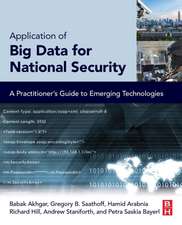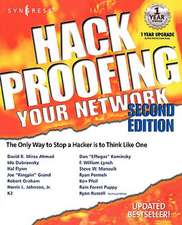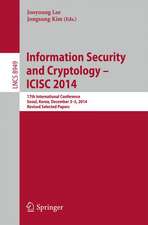Hackproofing Your Wireless Network
Autor Syngressen Limba Engleză Paperback – 22 mar 2002
Wireless technology is a new and rapidly growing field of concentration for network engineers and administrators. Innovative technology is now making the communication between computers a cordless affair. Wireless devices and networks are vulnerable to additional security risks because of their presence in the mobile environment.
Hack Proofing Your Wireless Network is the only book written specifically for architects, engineers, and administrators responsible for securing their wireless networks. From making sense of the various acronyms (WAP, WEP, SSL, PKE, PKI, SSL, SSH, IPSEC) to the implementation of security policies, plans, and recovery protocols, this book will help users secure their wireless network before its security is compromised. The only way to stop a hacker is to think like one...this book details the multiple ways a hacker can attack a wireless network - and then provides users with the knowledge they need to prevent said attacks.
- Uses forensic-based analysis to give the reader an insight into the mind of a hacker
- With the growth of wireless networks architects, engineers and administrators will need this book
- Up to the minute Web based support at www.solutions@syngress.com
Preț: 384.73 lei
Preț vechi: 480.91 lei
-20% Nou
Puncte Express: 577
Preț estimativ în valută:
73.62€ • 77.07$ • 60.91£
73.62€ • 77.07$ • 60.91£
Carte tipărită la comandă
Livrare economică 05-19 aprilie
Preluare comenzi: 021 569.72.76
Specificații
ISBN-13: 9781928994596
ISBN-10: 1928994598
Pagini: 608
Dimensiuni: 175 x 245 x 30 mm
Greutate: 0.91 kg
Editura: ELSEVIER SCIENCE
ISBN-10: 1928994598
Pagini: 608
Dimensiuni: 175 x 245 x 30 mm
Greutate: 0.91 kg
Editura: ELSEVIER SCIENCE
Public țintă
This book is written for architects, engineers and administrators responsible with protecting the increasing number of wireless networksCuprins
Foreword
Chapter 1 The Wireless Challenge
Introduction
Wireless Technology Overview
Defining Cellular-based Wireless
Defining the Wireless LAN
The Convergence of Wireless Technologies
Trends and Statistics
Understanding the Promise of Wireless
Wireless Networking
Understanding the Benefits of Wireless
Convenience
Affordability
Speed
Aesthetics
Productivity
Facing the Reality of Wireless Today
Standards Conflicts
Commercial Conflicts
Market Adoption Challenges
The Limitations of “Radio
The Limitations of Wireless Security
Examining the Wireless Standards
Cellular-based Wireless Networks
Wireless LAN Networks
Understanding Public Key Infrastructures and Wireless Networking
Summary
Solutions Fast Track
Frequently Asked Questions
Chapter 2 A Security Primer
Introduction
Understanding Security Fundamentals and Principles of Protection
Ensuring Confidentiality
Ensuring Integrity
Ensuring Availability
Ensuring Privacy
Ensuring Authentication
Ensuring Authorization
Ensuring Non-repudiation
Accounting and Audit Trails
Using Encryption
Reviewing the Role of Policy
Identifying Resources
Understanding Classification Criteria
Implementing Policy
Recognizing Accepted Security and Privacy Standards
Reviewing Security Standards
Reviewing Privacy Standards and Regulations
Addressing Common Risks and Threats
Experiencing Loss of Data
Experiencing Denial and Disruption of Service
Eavesdropping
Preempting the Consequences of an Organization’s Loss
Summary
Solutions Fast Track
Frequently Asked Questions
Chapter 3 Wireless Network
Architecture and Design
Introduction
Fixed Wireless Technologies
Multichannel Multipoint Distribution Service
Local Multipoint Distribution Services
Wireless Local Loop
Point-to-Point Microwave
Wireless Local Area Networks
Why the Need for a Wireless LAN Standard?
Developing WLANs through the 802.11 Architecture
The Basic Service Set
The Extended Service Set
The CSMA-CA Mechanism
Configuring Fragmentation
Using Power Management Options
Multicell Roaming
Security in the WLAN
Developing WPANs through the 802.15 Architecture
Bluetooth
HomeRF
High Performance Radio LAN
Mobile Wireless Technologies
First Generation Technologies
Second Generation Technologies
2.5G Technology
Third Generation Technologies
Wireless Application Protocol
Global System for Mobile Communications
General Packet Radio Service
Short Message Service
Optical Wireless Technologies
Exploring the Design Process
Conducting the Preliminary Investigation
Performing Analysis of the Existing Environment
Creating a Preliminary Design
Finalizing the Detailed Design
Executing the Implementation
Capturing the Documentation
Creating the Design Methodology
Creating the Network Plan
Developing the Network Architecture
Reviewing and Validating the Planning Phase
Creating a High-Level Topology
Creating a Collocation Architecture
Defining the High-Level Services
Formalizing the Detailed Design Phase
Understanding Wireless Network Attributes from a Design Perspective
Application Support
Physical Landscape
Network Topology
Summary
Solutions Fast Track
Frequently Asked Questions
Chapter 4 Common Attacks and Vulnerabilities
Introduction
The Weaknesses in WEP
Criticisms of the Overall Design
Weaknesses in the Encryption Algorithm
Weaknesses in Key Management
Weaknesses in User Behavior
Conducting Reconnaissance
Finding a Target
Finding Weaknesses in a Target
Exploiting Those Weaknesses
Sniffing, Interception, and Eavesdropping
Defining Sniffing
Sample Sniffing Tools
Sniffing Case Scenario
Protecting Against Sniffing and Eavesdropping
Spoofing and Unauthorized Access
Defining Spoofing
Sample Spoofing Tools
Spoofing Case Scenario
Protecting Against Spoofing and Unauthorized Attacks
Network Hijacking and Modification
Defining Hijacking
Sample Hijacking Tools
Hijacking Case Scenario
Protection against Network Hijacking and Modification
Denial of Service and Flooding Attacks
Defining DoS and Flooding
Sample DoS Tools
DoS and Flooding Case Scenario
Protecting Against DoS and Flooding Attacks
The Introduction of Malware
Stealing User Devices
Summary
Solutions Fast Track
Frequently Asked Questions
Chapter 5 Wireless Security Countermeasures
Introduction
Revisiting Policy
Addressing the Issues with Policy
Analyzing the Threat
Threat Equals Risk Plus Vulnerability
Designing and Deploying a Secure Network
Implementing WEP
Defining WEP
Creating Privacy with WEP
The WEP Authentication Process
WEP Benefits and Advantages
WEP Disadvantages
The Security Implications of Using WEP
Implementing WEP on the Aironet
Implementing WEP on the ORiNOCO AP-1000
Securing a WLAN with WEP: A Case Scenario
Filtering MACs
Defining MAC Filtering
MAC Benefits and Advantages
MAC Disadvantages
Security Implications of MAC Filtering
Implementing MAC Filters on the AP-1000
Implementing MAC Filters on the Aironet 340
Filtering MAC Addresses: A Case Scenario
Filtering Protocols
Defining Protocol Filters
Protocol Filter Benefits and Advantages
Protocol Filter Disadvantages
Security Implications of Using Protocol Filters
Using Closed Systems and Networks
Defining a Closed System
Closed System Benefits and Advantages
Closed System Disadvantages
Security Implications of Using a Closed System
A Closed Environment on a Cisco Aironet Series AP
A Closed Environment on an ORiNOCO AP-1000
Implementing a Closed System: A Case Scenario
Enabling WEP on the ORiNOCO Client
Allotting IPs
Defining IP Allocation on the WLAN
Deploying IP over the WLAN: Benefits and Advantages
Deploying IP over the WLAN: Disadvantages
Security Implications of Deploying IP over the WLAN
Deploying IP over the WLAN: A Case Scenario
Using VPNs
VPN Benefits and Advantages
VPN Disadvantages
Security Implications of Using a VPN
Layering Your Protection Using a VPN
Utilizing a VPN:A Case Scenario
Securing Users
End User Security Benefits and Advantages
End User Security Disadvantages
User Security: A Case Scenario
Summary
Solutions Fast Track
Frequently Asked Questions
Chapter 6 Circumventing Security Measures
Introduction
Planning and Preparations
Finding a Target
Detecting an Open System
Detecting a Closed System
Exploiting WEP
Security of 64-bit versus 128-bit Keys
Acquiring a WEP Key
War Driving
What Threat Do These “Open Networks Pose to Network Security?
Stealing User Devices
What Are the Benefits of Device Theft?
MAC Filtering
Determining MAC Filtering Is Enabled
MAC Spoofing
Bypassing Advanced Security Mechanisms
Firewalls
What Happens Now?
Exploiting Insiders
Installing Rogue Access Points
Where Is the Best Location for a Rogue AP?
Configuring the Rogue AP
Risks Created by a Rogue AP
Are Rogue APs Detectable?
Exploiting VPNs
Summary
Solutions Fast Track
Frequently Asked Questions
Chapter 7 Monitoring and Intrusion Detection
Introduction
Designing for Detection
Starting with a Closed Network
Ruling Out Environmental Obstacles
Ruling Out Interference
Defensive Monitoring Considerations
Availability and Connectivity
Monitoring for Performance
Intrusion Detection Strategies
Integrated Security Monitoring
Popular Monitoring Products
Conducting Vulnerability Assessments
Incident Response and Handling
Policies and Procedures
Reactive Measures
Reporting
Cleanup
Prevention
Conducting Site Surveys for Rogue Access Points
The Rogue Placement
Summary
Solutions Fast Track
Frequently Asked Questions
Chapter 8 Auditing
Introduction
Designing and Planning a Successful Audit
Types of Audits
When to Perform an Audit
Auditing Activities
Auditing Tools
Critical Auditing Success Factors
Defining Standards
Standards
Guidelines
Best Practices
Policies
Procedures
Auditing, Security Standards, and Best Practices
Corporate Security Policies
Auditing Charters and Irregularities
Establishing the Audit Scope
Establishing the Documentation Process
Performing the Audit
Auditors and Technologists
Obtaining Support from IS/IT Departments
Gathering Data
Analyzing Audit Data
Matrix Analysis
Recommendations Reports
Generating Audit Reports
The Importance of Audit Report Quality
Writing the Audit Report
Final Thoughts on Auditing
Sample Audit Reports
Summary
Solutions Fast Track
Frequently Asked Questions
Chapter 9 Case Scenarios
Introduction
Implementing a Non-secure Wireless Network
Implementing an Ultra-secure Wireless LAN
Physical Location and Access
Configuring the AP
Designing Securely
Securing by Policy
Taking a War Drive
Scouting Your Location
Installing in Difficult Situations
Developing a Wireless Security Checklist
Minimum Security
Moderate Security
Optimal Security
Summary
Solutions Fast Track
Frequently Asked Questions
Appendix: Hack Proofing Your Wireless Network Fast Track
Index


























